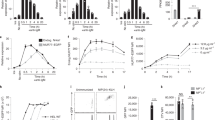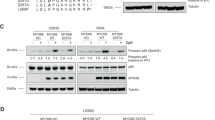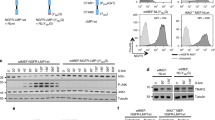Abstract
NF-κB (Rel) transcription factors control physiological and pathological immune cell function. The scaffold proteins Bcl-10 and MALT1 couple antigen-receptor signals to the canonical NF-κB pathway and are pivotal in lymphomagenesis. Here we found that Bcl-10 and MALT1 differentially regulated B cell receptor–induced activation of RelA and c-Rel. Bcl-10 was essential for recruitment of the kinase IKK into lipid rafts for the activation of RelA and c-Rel, for blocking apoptosis and for inducing division after B cell receptor ligation. In contrast, MALT1 participated in survival signaling but was not involved in IKK recruitment or activation and was dispensable for RelA induction and proliferation. MALT1 selectively activated c-Rel to control a distinct subprogram. Our results provide mechanistic insights into B cell receptor–induced survival and proliferation signals and demonstrate the selective control of c-Rel in the canonical NF-κB pathway.
This is a preview of subscription content, access via your institution
Access options
Subscribe to this journal
Receive 12 print issues and online access
$209.00 per year
only $17.42 per issue
Buy this article
- Purchase on SpringerLink
- Instant access to full article PDF
Prices may be subject to local taxes which are calculated during checkout








Similar content being viewed by others
References
Hayden, M.S. & Ghosh, S. Signaling to NF-κB. Genes Dev. 18, 2195–2224 (2004).
Ghosh, S. & Karin, M. Missing pieces in the NF-κB puzzle. Cell 109 Suppl, S81–S96 (2002).
Gerondakis, S. et al. Unravelling the complexities of the NF-κB signalling pathway using mouse knockout and transgenic models. Oncogene 25, 6781–6799 (2006).
Kurosaki, T. Regulation of B-cell signal transduction by adaptor proteins. Nat. Rev. Immunol. 2, 354–363 (2002).
Siebenlist, U., Brown, K. & Claudio, E. Control of lymphocyte development by nuclear factor-κB. Nat. Rev. Immunol. 5, 435–445 (2005).
Thome, M. CARMA1, BCL-10 and MALT1 in lymphocyte development and activation. Nat. Rev. Immunol. 4, 348–359 (2004).
Ruland, J. & Mak, T.W. Transducing signals from antigen receptors to nuclear factor κB. Immunol. Rev. 193, 93–100 (2003).
Su, T.T. et al. PKC-β controls IκB kinase lipid raft recruitment and activation in response to BCR signaling. Nat. Immunol. 3, 780–786 (2002).
Moreno-Garcia, M.E., Sommer, K.M., Bandaranayake, A.D. & Rawlings, D.J. Proximal signals controlling B-cell antigen receptor (BCR) mediated NF-κB activation. Adv. Exp. Med. Biol. 584, 89–106 (2006).
Sommer, K. et al. Phosphorylation of the CARMA1 linker controls NF-κB activation. Immunity 23, 561–574 (2005).
Rawlings, D.J., Sommer, K. & Moreno-Garcia, M.E. The CARMA1 signalosome links the signaling machinery of adaptive and innate immunity in lymphocytes. Nat. Rev. Immunol. 6, 799–812 (2006).
Jost, P.J. & Ruland, J. Aberrant NF-κB signaling in lymphoma: mechanisms, consequences, and therapeutic implications. Blood 109, 2700–2707 (2007).
Alizadeh, A.A. et al. Distinct types of diffuse large B-cell lymphoma identified by gene expression profiling. Nature 403, 503–511 (2000).
Shipp, M.A. et al. Diffuse large B-cell lymphoma outcome prediction by gene-expression profiling and supervised machine learning. Nat. Med. 8, 68–74 (2002).
Ngo, V.N. et al. A loss-of-function RNA interference screen for molecular targets in cancer. Nature 441, 106–110 (2006).
Isaacson, P.G. & Du, M.Q. MALT lymphoma: from morphology to molecules. Nat. Rev. Cancer 4, 644–653 (2004).
Wegener, E. & Krappmann, D. CARD-Bcl10-Malt1 signalosomes: missing link to NF-κB. Sci. STKE 384, pe21 (2007).
Ruland, J., Duncan, G.S., Wakeham, A. & Mak, T.W. Differential requirement for Malt1 in T and B cell antigen receptor signaling. Immunity 19, 749–758 (2003).
Ruland, J. et al. Bcl10 is a positive regulator of antigen receptor-induced activation of NF-κB and neural tube closure. Cell 104, 33–42 (2001).
Loder, F. et al. B cell development in the spleen takes place in discrete steps and is determined by the quality of B cell receptor-derived signals. J. Exp. Med. 190, 75–89 (1999).
Solvason, N. et al. Transgene expression of Bcl-xL permits anti-immunoglobulin (Ig)-induced proliferation in xid B cells. J. Exp. Med. 187, 1081–1091 (1998).
Vigorito, E., Gambardella, L., Colucci, F., McAdam, S. & Turner, M. Vav proteins regulate peripheral B-cell survival. Blood 106, 2391–2398 (2005).
Schram, B.R. & Rothstein, T.L. NF-κB is required for surface Ig-induced Fas resistance in B cells. J. Immunol. 170, 3118–3124 (2003).
Ogilvy, S. et al. Constitutive Bcl-2 expression throughout the hematopoietic compartment affects multiple lineages and enhances progenitor cell survival. Proc. Natl. Acad. Sci. USA 96, 14943–14948 (1999).
Cheng, P.C., Dykstra, M.L., Mitchell, R.N. & Pierce, S.K. A role for lipid rafts in B cell antigen receptor signaling and antigen targeting. J. Exp. Med. 190, 1549–1560 (1999).
Xue, L. et al. Defective development and function of Bcl10-deficient follicular, marginal zone and B1 B cells. Nat. Immunol. 4, 857–865 (2003).
Bajpai, U.D., Zhang, K., Teutsch, M., Sen, R. & Wortis, H.H. Bruton's tyrosine kinase links the B cell receptor to nuclear factor κB activation. J. Exp. Med. 191, 1735–1744 (2000).
Ruefli-Brasse, A.A., French, D.M. & Dixit, V.M. Regulation of NF-κB-dependent lymphocyte activation and development by paracaspase. Science 302, 1581–1584 (2003).
Hara, H. et al. The MAGUK family protein CARD11 is essential for lymphocyte activation. Immunity 18, 763–775 (2003).
Grumont, R.J. et al. B lymphocytes differentially use the Rel and nuclear factor κB1 (NF-κB1) transcription factors to regulate cell cycle progression and apoptosis in quiescent and mitogen-activated cells. J. Exp. Med. 187, 663–674 (1998).
Grossmann, M. et al. The anti-apoptotic activities of Rel and RelA required during B-cell maturation involve the regulation of Bcl-2 expression. EMBO J. 19, 6351–6360 (2000).
Monroe, J.G. ITAM-mediated tonic signalling through pre-BCR and BCR complexes. Nat. Rev. Immunol. 6, 283–294 (2006).
Chen, C., Edelstein, L.C. & Gelinas, C. The Rel/NF-κB family directly activates expression of the apoptosis inhibitor Bcl-xL . Mol. Cell. Biol. 20, 2687–2695 (2000).
Budd, R.C., Yeh, W.C. & Tschopp, J. cFLIP regulation of lymphocyte activation and development. Nat. Rev. Immunol. 6, 196–204 (2006).
Grumont, R.J., Rourke, I.J. & Gerondakis, S. Rel-dependent induction of A1 transcription is required to protect B cells from antigen receptor ligation-induced apoptosis. Genes Dev. 13, 400–411 (1999).
Kontgen, F. et al. Mice lacking the c-rel proto-oncogene exhibit defects in lymphocyte proliferation, humoral immunity, and interleukin-2 expression. Genes Dev. 9, 1965–1977 (1995).
Liou, H.C., Sha, W.C., Scott, M.L. & Baltimore, D. Sequential induction of NF-κB/Rel family proteins during B-cell terminal differentiation. Mol. Cell. Biol. 14, 5349–5359 (1994).
Grumont, R.J. & Gerondakis, S. The subunit composition of NF-κB complexes changes during B-cell development. Cell Growth Differ. 5, 1321–1331 (1994).
Miyamoto, S., Schmitt, M.J. & Verma, I.M. Qualitative changes in the subunit composition of κB-binding complexes during murine B-cell differentiation. Proc. Natl. Acad. Sci. USA 91, 5056–5060 (1994).
Gilmore, T.D., Kalaitzidis, D., Liang, M.C. & Starczynowski, D.T. The c-Rel transcription factor and B-cell proliferation: a deal with the devil. Oncogene 23, 2275–2286 (2004).
Zhang, W., Trible, R.P. & Samelson, L.E. LAT palmitoylation: its essential role in membrane microdomain targeting and tyrosine phosphorylation during T cell activation. Immunity 9, 239–246 (1998).
Gross, O. et al. Card9 controls a non-TLR signalling pathway for innate anti-fungal immunity. Nature 442, 651–656 (2006).
Acknowledgements
We thank F. Greten, T. Mak and M. Reth for scientific discussions; M. Schiemann for cell sorting; G. Häcker (Technical University Munich) for vav-Bcl2 transgenic mice; V. Dixit (Genentech) for anti-MALT1; and E. Muggleton for critically reading the manuscript. Supported by Deutsche Forschungsgemeinschaft (Sonderforschungsbereiche grants) and Deutsche Krebshilfe (Max-Eder-Program grant to J.R).
Author information
Authors and Affiliations
Contributions
J.R. designed and coordinated the study, analyzed data and wrote the paper; U.F. coordinated the study, did experiments, analyzed data and contributed to manuscript writing; D.K. and C.P. contributed intellectual input; and C.M.z.B., A.G., E.W. and S.R. cooperated in experiments and data analysis.
Corresponding author
Ethics declarations
Competing interests
The authors declare no competing financial interests.
Supplementary information
Supplementary Text and Figures
Supplementary Figures 1–2 (PDF 778 kb)
Rights and permissions
About this article
Cite this article
Ferch, U., Büschenfelde, C., Gewies, A. et al. MALT1 directs B cell receptor–induced canonical nuclear factor-κB signaling selectively to the c-Rel subunit. Nat Immunol 8, 984–991 (2007). https://doi.org/10.1038/ni1493
Received:
Accepted:
Published:
Issue Date:
DOI: https://doi.org/10.1038/ni1493
This article is cited by
-
B-cell leukemia/lymphoma 10 promotes angiogenesis in an experimental corneal neovascularization model
Eye (2018)
-
Conversion of the LIMA1 tumour suppressor into an oncogenic LMO-like protein by API2–MALT1 in MALT lymphoma
Nature Communications (2015)
-
Combined Immunodeficiency Due to MALT1 Mutations, Treated by Hematopoietic Cell Transplantation
Journal of Clinical Immunology (2015)
-
New insights into pre-BCR and BCR signalling with relevance to B cell malignancies
Nature Reviews Immunology (2013)
-
Bcl10 is an essential regulator for A20 gene expression
Journal of Physiology and Biochemistry (2013)



